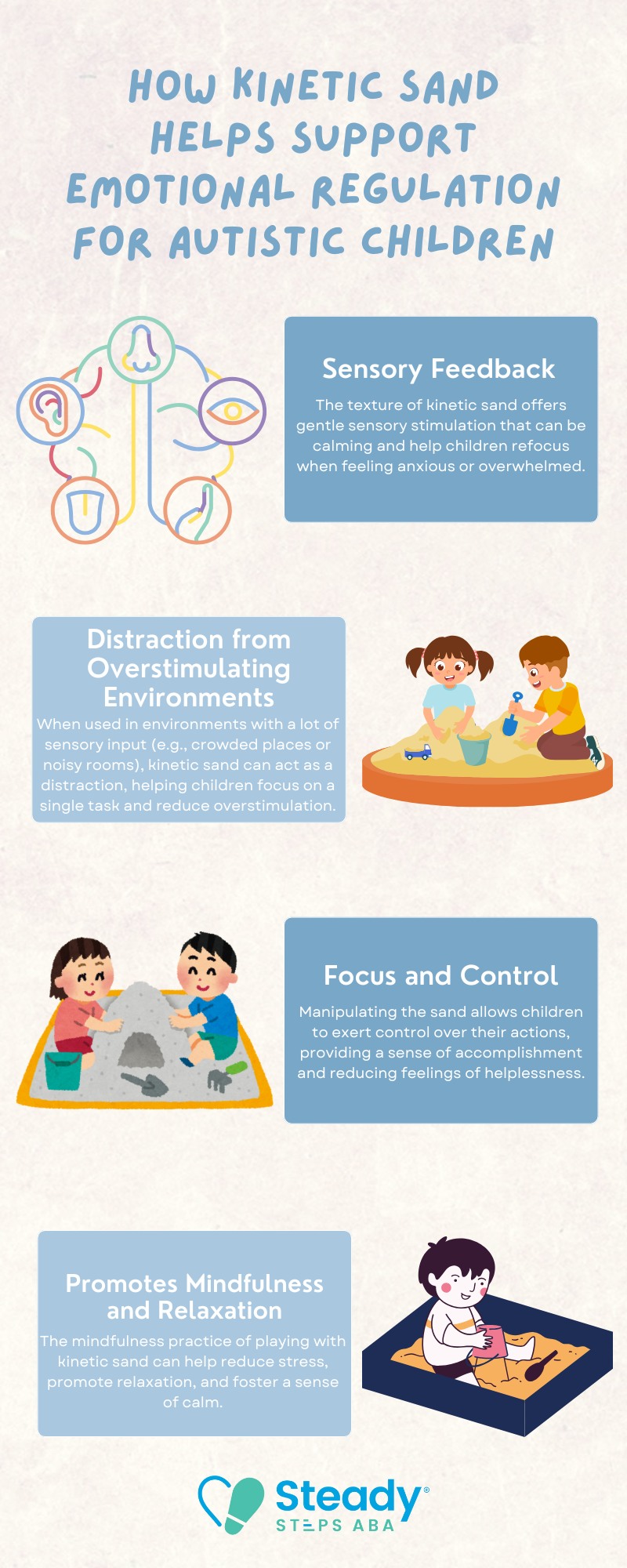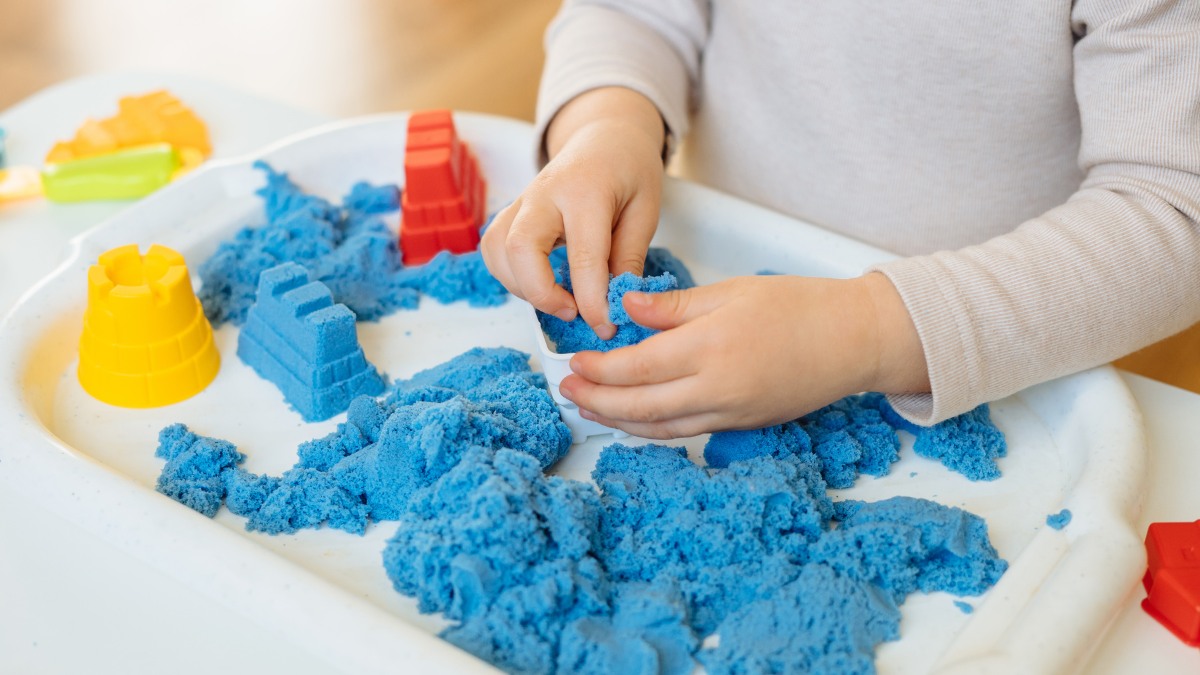Key Points:
- Kinetic sand for autism provides therapeutic benefits by engaging sensory needs and promoting fine motor skills.
- It can help with emotional regulation by offering a calming and tactile experience for children on the autism spectrum.
- Kinetic sand activities can support children in developing focus, creativity, and social interaction.
For children with autism, finding activities that provide sensory stimulation and help with emotional regulation can be vital. Kinetic sand for autism offers a unique and effective way to engage kids in a fun, interactive, and calming activity. With its soft, moldable texture, kinetic sand serves as both a sensory and creative tool, promoting fine motor skills and helping children self-regulate.
Incorporating kinetic sand into daily routines can help children on the autism spectrum interact with their environment in a safe and productive way. Whether it’s used for relaxation, play, or therapy, kinetic sand can offer a multitude of benefits to children who need sensory input or help focusing and developing social skills. Below, we’ll explore how kinetic sand can support children with autism in different ways.
Is Kinetic Sand Good for Autism?
Yes. Kinetic sand can be a great sensory tool for individuals with autism. Its unique texture offers tactile stimulation that can help reduce anxiety and promote focus, while its moldable nature encourages creativity and fine motor development. Many children on the spectrum find the repetitive motions of squishing and shaping the sand calming, which makes it a useful addition to sensory play activities. However, it’s important to supervise use, especially for those who may mouth non-food items.
What is Kinetic Sand and Why Is It Beneficial for Kids with Autism?
Kinetic sand is a unique material that feels similar to sand but has a special, almost clay-like texture due to a coating of silicone oil. It flows and moves, but it also sticks together, allowing children to mold and shape it into different forms. This makes it highly engaging and provides a wide range of sensory experiences.
When it comes to kinetic sand for autism, its benefits are more than just tactile enjoyment. The tactile feedback children experience while playing with kinetic sand can assist in calming the sensory system, reducing anxiety, and helping to focus attention on a single task. For children who are easily overwhelmed by other sensory inputs, kinetic sand can serve as a grounding tool to help them self-soothe and focus.
Here are some of the key benefits of kinetic sand for autism:
1. Sensory Regulation
The feel of kinetic sand can be calming for children who have trouble regulating sensory input. It’s often used to provide proprioceptive feedback, which can help children feel more in control of their environment.
2. Fine Motor Skills Development
Playing with kinetic sand involves using small hand and finger movements to mold and shape the sand, which helps in strengthening fine motor skills.
3. Stress Relief and Calming Effect
The repetitive motions involved in manipulating the sand can have a soothing effect on children with autism who experience high levels of anxiety or emotional distress.
How Does Kinetic Sand Support Fine Motor Development in Kids with Autism
Fine motor skills are crucial for everyday tasks such as writing, eating, dressing, and manipulating objects. Kinetic sand for autism offers a natural way to support the development of these skills by encouraging children to use their hands and fingers in a focused way.
The act of shaping, squeezing, and rolling the sand requires children to practice hand-eye coordination, finger strength, and dexterity. For children with autism, whose motor development might differ from neurotypical peers, engaging in activities like kinetic sand play can be a helpful and enjoyable way to work on these skills.
Kinetic sand can also help children develop spatial awareness, which is critical for understanding how objects relate to one another in space. When children mold or build with kinetic sand, they practice visual-spatial processing as they figure out how to shape the sand into desired forms.
Here are some ways kinetic sand helps with promoting fine motor development:
1. Gripping and Pinching
Kids can practice gripping and pinching the sand to form shapes, which strengthens their finger muscles and improves dexterity.
2. Rolling and Squeezing
Rolling the sand into balls or squeezing it between fingers helps build hand strength and coordination.
3. Building Structures
Creating small structures with kinetic sand promotes coordination and teaches concepts like balance and shape recognition.
Using Kinetic Sand to Help Kids with Autism Self-Regulate
Many children on the autism spectrum struggle with emotional regulation, and finding effective ways to calm down and focus can be challenging. Kinetic sand for autism can provide a simple but powerful tool for helping children regulate their emotions, especially in moments of stress, overstimulation, or frustration.
The soothing, tactile nature of kinetic sand offers sensory input that can serve as a grounding mechanism. By focusing on the sensation of moving and shaping the sand, children can shift their attention away from overwhelming stimuli, which in turn helps them self-soothe and regain emotional control. If you’re interested in understanding how a lack of sensory input can impact children on the spectrum, our article “Understimulation in Autism: What Parents Need to Know“ takes a closer look at how to recognize and address these often-overlooked challenges.
For some children, the calming effect of kinetic sand is immediate and noticeable, while for others, it might take more time or be paired with other calming techniques.
Here’s how kinetic sand can help with emotional regulation:

Kinetic Sand as a Sensory Tool for Social Growth in Autism
Socialization can be a significant challenge for children with autism, especially when it comes to learning appropriate communication skills, turn-taking, and playing cooperatively. Kinetic sand for autism offers an opportunity for social interaction in a low-pressure, engaging environment.
Since kinetic sand is often used for collaborative play, it provides an opportunity for children to practice social skills such as sharing, taking turns, and initiating conversations. Additionally, it can encourage imaginative play and creativity, which are key elements in developing social understanding.
Kinetic sand can be used in therapy sessions or in group play to foster connections with others, making it a great tool for both solo and social play.
Here are some ways kinetic sand supports social interaction in children with autism:
1. Group Play
Working together to create sand sculptures or other shared tasks promotes communication and cooperation. By using kinetic sand, children with autism can learn skills to share and play with their peers.
2. Role-playing and Pretend Play
Children can use the sand as part of their imaginative play, which often encourages verbal interaction with others.
3. Therapeutic Play Sessions
ABA therapists can incorporate kinetic sand into therapy sessions, using it to teach social skills, turn-taking, and appropriate verbal communication.
Help Your Child Thrive with ABA Therapy Today
Integrating sensory tools like kinetic sand for autism can play a pivotal role in supporting a child’s development. Whether it’s helping with emotional regulation, fine motor skills, or socialization, kinetic sand offers a versatile and effective tool for children on the autism spectrum.
At Steady Steps ABA, we understand the importance of providing a variety of sensory-rich activities for children with autism to promote development. We offer ABA therapy in Maryland to help children enhance their skills, regulate emotions, and engage in therapeutic play.
If you’re looking for personalized support for your child, we are here to help guide you through a successful journey of growth and learning. Get in touch with us today to learn how our ABA therapy services in Maryland can incorporate sensory-based activities like kinetic sand to improve your child’s developmental progress!






